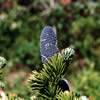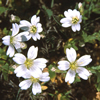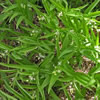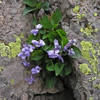Intermountain Region
You Are There! Hike the Highline Trail
Subalpine Coniferous Forest
 The subalpine coniferous forest is darker, thicker, and the canopy is closed with overhanging and often dead branches. Photo by Charmaine Delmatier.
The subalpine coniferous forest is darker, thicker, and the canopy is closed with overhanging and often dead branches. Photo by Charmaine Delmatier.
 Aspen show their splendor in late summer, early fall with their bright yellow to red-orange trembling leaves. Photo by Charmaine Delmatier.
Aspen show their splendor in late summer, early fall with their bright yellow to red-orange trembling leaves. Photo by Charmaine Delmatier.
 Forest openings teem with beautiful mountain wildflower meadows. Photo by Susan Marsh.
Forest openings teem with beautiful mountain wildflower meadows. Photo by Susan Marsh.
As we travel higher, we begin to enter the subalpine coniferous forest. It is darker, the trees are thicker, and the canopy is closed in, with overhanging and often dead branches from tall conifers such as lodge-pole pine (Pinus contorta var. latifolia), limber pine (Pinus flexilis), whitebark pine (Pinus albicaulis), Engelmann spruce (Picea engelmannii), Douglas fir (Pseudotsuga menziesii var. glauca), and subalpine fir (Abies lasiocarpa var. lasiocarpa). Underneath the shady canopy of these tall conifers, the diversity of wildflowers declines. Here and there, several mountain shrubs and woody forbs are able to take advantage of this understory environment.
Up ahead where the tree canopy lets a bit of light through, some hardwoods and shrubs have become established, including dogwood (Cornus sericea ssp. sericea) and chokecherry (Prunus virginiana var. melanocarpa). Aspens will also search for a sunny spot in the darker forest. Where the forest is completely open, aspens form large groves that dot the landscape and show their splendor in late summer, early fall with their bright yellow to red-orange trembling leaves contrasted against the dark-green coniferous forest creating a mountain mosaic of vibrant colors for miles. Find out more about aspen and challenges to maintaining this species in the western landscape in our Celebrating Wildflowers article, Fading Gold: The Decline of Aspen in the West.
Up ahead where some light has been able to break though the conifer canopy, there is a sea of yellow on the forest floor generated by a beautiful display of mountain arnica (Arnica cordifolia, gracillis, and latifolia). Some species of Arnica have medicinal properties such as relief of topical wounds and bruises, and providing temporary relief from joint pain. Persistent and hardy perennial wildflowers are nestled in and among the understory shrubs and fallen organic material, such as wild rose (Rosa woodsii). Scattered throughout the forest floor are both white (Drymocallis arguata) and yellow cinquefoil (Potentilla sp.).
At this elevation, most forest openings are painted with seas of yellow-flowered arrowleaf balsamroot (Balsamorhiza sagittata) and brilliant-blue mountain lupines (Lupinus argenteus). Interspersed within the yellow and purple landscape are the brilliant red flowering bracts of red paintbrush (Castilleja angustifolia var. dubia). While hiking along the trail, be sure to look for the very small monkey flower (Mimulus sp.) nestled in the moist crevices of large granite boulders. If we look closely, we will notice that many mountain pollinators are incredibly beautiful.
Subalpine Coniferous Forest Photo Gallery
 Abies lasiocarpa (subalpine fir). Photo by Susan McDougal.
Abies lasiocarpa (subalpine fir). Photo by Susan McDougal.
 Achillea millefolium. Photo by Al Schneider.
Achillea millefolium. Photo by Al Schneider.
 Arnica latifolia. Photo by Sherel Goodrich.
Arnica latifolia. Photo by Sherel Goodrich.
 Aster glaucodes. Photo by Charmaine Delmatier.
Aster glaucodes. Photo by Charmaine Delmatier.
 Balsamorhiza sagittata. Photo by Charmaine Delmatier.
Balsamorhiza sagittata. Photo by Charmaine Delmatier.
 Bessya wyomingensis. Photo by Charmaine Delmatier.
Bessya wyomingensis. Photo by Charmaine Delmatier.
 Campanula rotundifolia. Photo by Teresa Prendusi.
Campanula rotundifolia. Photo by Teresa Prendusi.
 Castilleja angustifolia var. dubia. Photo by Charmaine Delmatier.
Castilleja angustifolia var. dubia. Photo by Charmaine Delmatier.
 Castilleja linariifolia. Photo by Al Schneider.
Castilleja linariifolia. Photo by Al Schneider.
 Cerastium arvense. Photo by Charmaine Delmatier.
Cerastium arvense. Photo by Charmaine Delmatier.
 Draba aurea. Photo by Al Schneider.
Draba aurea. Photo by Al Schneider.
 Drymocallis arguata. Photo by Al Schneider.
Drymocallis arguata. Photo by Al Schneider.
 Erigeron speciosa. Photo by Charmaine Delmatier.
Erigeron speciosa. Photo by Charmaine Delmatier.
 Fritillaria atropupurea. Photo by Sherel Goodrich.
Fritillaria atropupurea. Photo by Sherel Goodrich.
 Geranium richardsonii. Photo by Teresa Prendusi.
Geranium richardsonii. Photo by Teresa Prendusi.
 Geranium viscosissimum. Photo by Teresa Prendusi.
Geranium viscosissimum. Photo by Teresa Prendusi.
 Geum triflorum. Photo by Charmaine Delmatier.
Geum triflorum. Photo by Charmaine Delmatier.
 Ipomopsis aggregata. Photo by Teresa Prendusi.
Ipomopsis aggregata. Photo by Teresa Prendusi.
 Linum lewisii. Photo by Al Schneider.
Linum lewisii. Photo by Al Schneider.
 Maianthemum stellatum. Photo by Al Schneider.
Maianthemum stellatum. Photo by Al Schneider.
 Pedicularis bracteosa. Photo by Teresa Prendusi.
Pedicularis bracteosa. Photo by Teresa Prendusi.
 Picea engelmannii (Engelmann spruce). Photo by Teresa Prendusi.
Picea engelmannii (Engelmann spruce). Photo by Teresa Prendusi.
 Pinus alibicaulis (whitebark pine). Photo by Gary Monroe.
Pinus alibicaulis (whitebark pine). Photo by Gary Monroe.
 Pinus contorta (lodgepole pine). Photo by Al Schneider.
Pinus contorta (lodgepole pine). Photo by Al Schneider.
 Pinus flexilis (limber pine). Photo courtesy USDA NRCS.
Pinus flexilis (limber pine). Photo courtesy USDA NRCS.
 Psuedotsuga menziesii (Douglas fir). Photo by Teresa Prendusi.
Psuedotsuga menziesii (Douglas fir). Photo by Teresa Prendusi.
 Pyrola asarifolia. Photo by Sherel Goodrich.
Pyrola asarifolia. Photo by Sherel Goodrich.
 Rosa woodsii. Photo by Al Schneider.
Rosa woodsii. Photo by Al Schneider.
 Saxifraga odontoloma. Photo by Al Schneider.
Saxifraga odontoloma. Photo by Al Schneider.
 Senecio triangularis. Photo by Charmaine Delmatier.
Senecio triangularis. Photo by Charmaine Delmatier.
 Trollius laxus. Photo by Teresa Prendusi.
Trollius laxus. Photo by Teresa Prendusi.
 Viola adunca. Photo by Al Schneider.
Viola adunca. Photo by Al Schneider.

